spare wheel CHEVROLET CAMARO 2010 5.G Owners Manual
[x] Cancel search | Manufacturer: CHEVROLET, Model Year: 2010, Model line: CAMARO, Model: CHEVROLET CAMARO 2010 5.GPages: 378, PDF Size: 5.75 MB
Page 234 of 378

Black plate (2,1)Chevrolet Camaro Owner Manual - 2010
9-2 Vehicle Care
Electrical System
Electrical SystemOverload . . . . . . . . . . . . . . . . . . . 9-41
Fuses and Circuit Breakers . . . . . . . . . . . . . . . . . . . 9-42
Engine Compartment Fuse
Block . . . . . . . . . . . . . . . . . . . . . . . 9-42
Instrument Panel Fuse Block . . . . . . . . . . . . . . . . . . . . . . . 9-45
Rear Compartment Fuse Block . . . . . . . . . . . . . . . . . . . . . . . 9-47
Wheels and Tires
Tires . . . . . . . . . . . . . . . . . . . . . . . . . 9-49
Winter Tires . . . . . . . . . . . . . . . . . . 9-49
Tire Sidewall Labeling . . . . . . . 9-50
Tire Designations . . . . . . . . . . . . 9-52
Tire Terminology andDefinitions . . . . . . . . . . . . . . . . . . 9-53
Tire Pressure . . . . . . . . . . . . . . . . 9-56 Tire Pressure for High-Speed
Operation . . . . . . . . . . . . . . . . . . 9-58
Tire Pressure Monitor System . . . . . . . . . . . . . . . . . . . . . 9-58
Tire Pressure Monitor
Operation . . . . . . . . . . . . . . . . . . 9-60
Tire Inspection . . . . . . . . . . . . . . . 9-63
Tire Rotation . . . . . . . . . . . . . . . . . 9-63
When It Is Time for New Tires . . . . . . . . . . . . . . . . . . . . . . . 9-64
Buying New Tires . . . . . . . . . . . . 9-65
Different Size Tires and Wheels . . . . . . . . . . . . . . . . . . . . . 9-67
Uniform Tire Quality Grading . . . . . . . . . . . . . . . . . . . . 9-67
Wheel Alignment and Tire Balance . . . . . . . . . . . . . . . . . . . . 9-69
Wheel Replacement . . . . . . . . . 9-69
Tire Chains . . . . . . . . . . . . . . . . . . 9-71 If a Tire Goes Flat . . . . . . . . . . . 9-71
Tire Sealant and
Compressor Kit . . . . . . . . . . . . . 9-73
Storing the Tire Sealant and Compressor Kit . . . . . . . . . . . . . 9-79
Tire Changing . . . . . . . . . . . . . . . 9-79
Compact Spare Tire . . . . . . . . . 9-85
Jump Starting
Jump Starting . . . . . . . . . . . . . . . . 9-86
Towing
Towing the Vehicle . . . . . . . . . . . 9-90
Recreational Vehicle Towing . . . . . . . . . . . . . . . . . . . . . 9-90
Appearance Care
Exterior Care . . . . . . . . . . . . . . . . 9-90
Interior Care . . . . . . . . . . . . . . . . . 9-95
Page 278 of 378
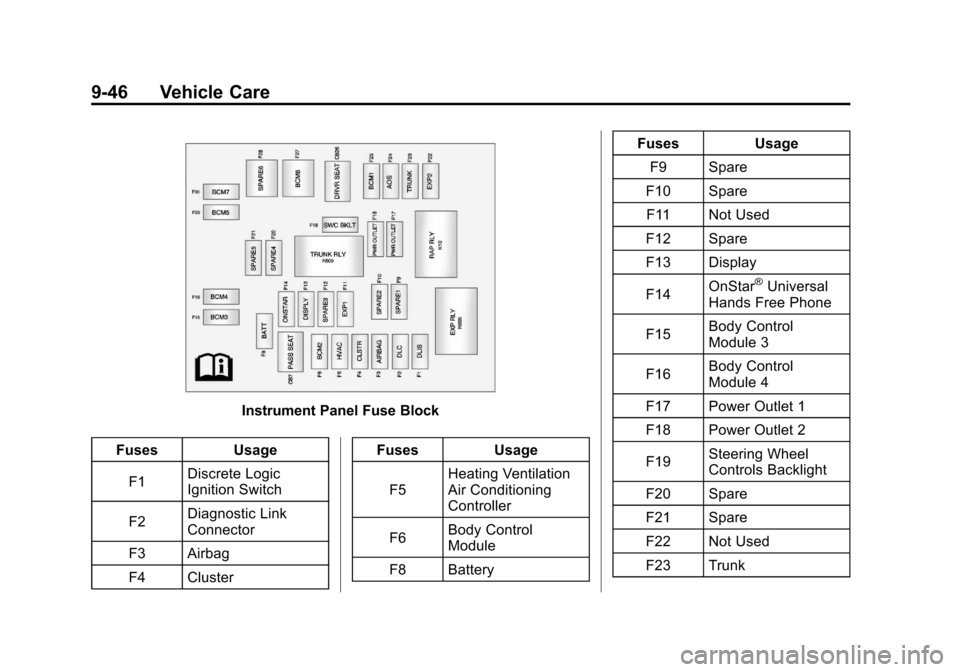
Black plate (46,1)Chevrolet Camaro Owner Manual - 2010
9-46 Vehicle Care
Instrument Panel Fuse Block
Fuses Usage
F1 Discrete Logic
Ignition Switch
F2 Diagnostic Link
Connector
F3 Airbag
F4 Cluster Fuses
Usage
F5 Heating Ventilation
Air Conditioning
Controller
F6 Body Control
Module
F8 Battery Fuses
Usage
F9 Spare
F10 Spare
F11 Not Used
F12 Spare
F13 Display
F14 OnStar
®Universal
Hands Free Phone
F15 Body Control
Module 3
F16 Body Control
Module 4
F17 Power Outlet 1
F18 Power Outlet 2
F19 Steering Wheel
Controls Backlight
F20 Spare
F21 Spare
F22 Not Used
F23 Trunk
Page 282 of 378
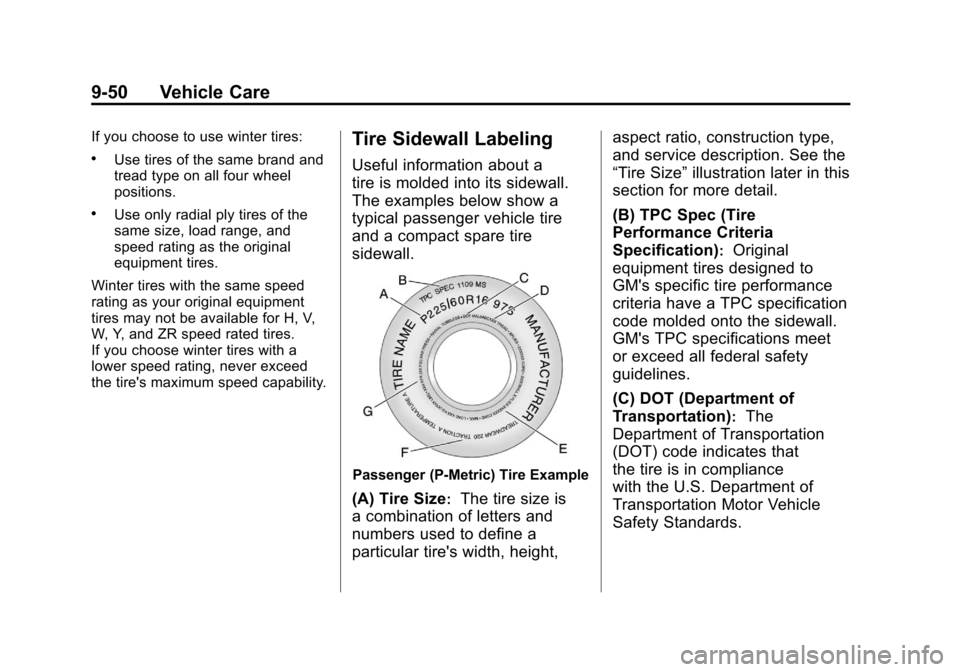
Black plate (50,1)Chevrolet Camaro Owner Manual - 2010
9-50 Vehicle Care
If you choose to use winter tires:
.Use tires of the same brand and
tread type on all four wheel
positions.
.Use only radial ply tires of the
same size, load range, and
speed rating as the original
equipment tires.
Winter tires with the same speed
rating as your original equipment
tires may not be available for H, V,
W, Y, and ZR speed rated tires.
If you choose winter tires with a
lower speed rating, never exceed
the tire's maximum speed capability.
Tire Sidewall Labeling
Useful information about a
tire is molded into its sidewall.
The examples below show a
typical passenger vehicle tire
and a compact spare tire
sidewall.
Passenger (P‐Metric) Tire Example
(A) Tire Size:The tire size is
a combination of letters and
numbers used to define a
particular tire's width, height, aspect ratio, construction type,
and service description. See the
“Tire Size”
illustration later in this
section for more detail.
(B) TPC Spec (Tire
Performance Criteria
Specification)
:Original
equipment tires designed to
GM's specific tire performance
criteria have a TPC specification
code molded onto the sidewall.
GM's TPC specifications meet
or exceed all federal safety
guidelines.
(C) DOT (Department of
Transportation)
:The
Department of Transportation
(DOT) code indicates that
the tire is in compliance
with the U.S. Department of
Transportation Motor Vehicle
Safety Standards.
Page 284 of 378
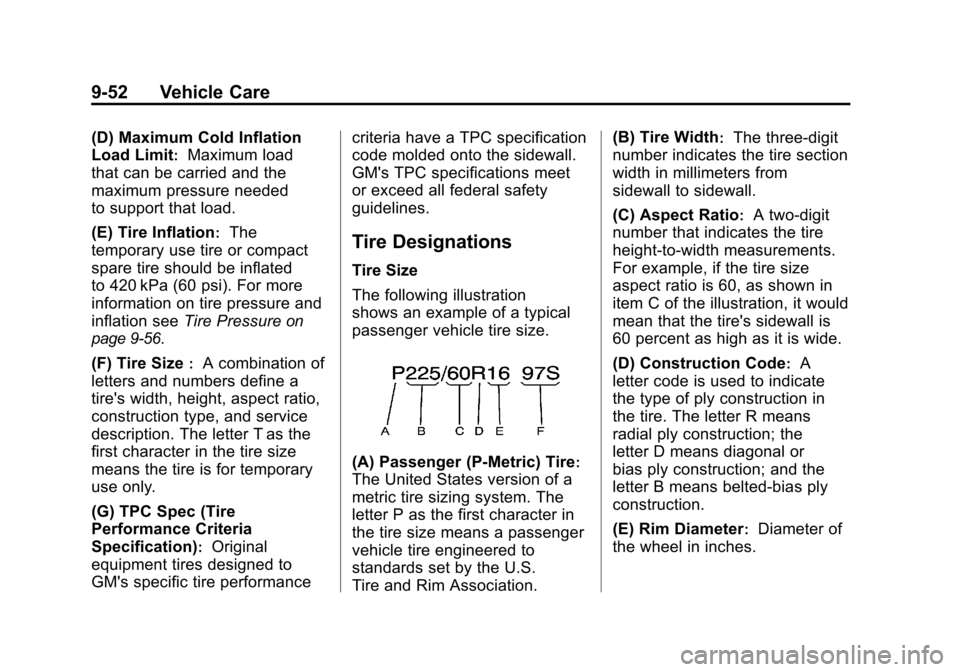
Black plate (52,1)Chevrolet Camaro Owner Manual - 2010
9-52 Vehicle Care
(D) Maximum Cold Inflation
Load Limit
:Maximum load
that can be carried and the
maximum pressure needed
to support that load.
(E) Tire Inflation
:The
temporary use tire or compact
spare tire should be inflated
to 420 kPa (60 psi). For more
information on tire pressure and
inflation see Tire Pressure
on
page 9‑56
.
(F) Tire Size
:A combination of
letters and numbers define a
tire's width, height, aspect ratio,
construction type, and service
description. The letter T as the
first character in the tire size
means the tire is for temporary
use only.
(G) TPC Spec (Tire
Performance Criteria
Specification)
:Original
equipment tires designed to
GM's specific tire performance criteria have a TPC specification
code molded onto the sidewall.
GM's TPC specifications meet
or exceed all federal safety
guidelines.
Tire Designations
Tire Size
The following illustration
shows an example of a typical
passenger vehicle tire size.
(A) Passenger (P‐Metric) Tire:
The United States version of a
metric tire sizing system. The
letter P as the first character in
the tire size means a passenger
vehicle tire engineered to
standards set by the U.S.
Tire and Rim Association.(B) Tire Width
:The three‐digit
number indicates the tire section
width in millimeters from
sidewall to sidewall.
(C) Aspect Ratio
:A two‐digit
number that indicates the tire
height‐to‐width measurements.
For example, if the tire size
aspect ratio is 60, as shown in
item C of the illustration, it would
mean that the tire's sidewall is
60 percent as high as it is wide.
(D) Construction Code
:A
letter code is used to indicate
the type of ply construction in
the tire. The letter R means
radial ply construction; the
letter D means diagonal or
bias ply construction; and the
letter B means belted‐bias ply
construction.
(E) Rim Diameter
:Diameter of
the wheel in inches.
Page 292 of 378
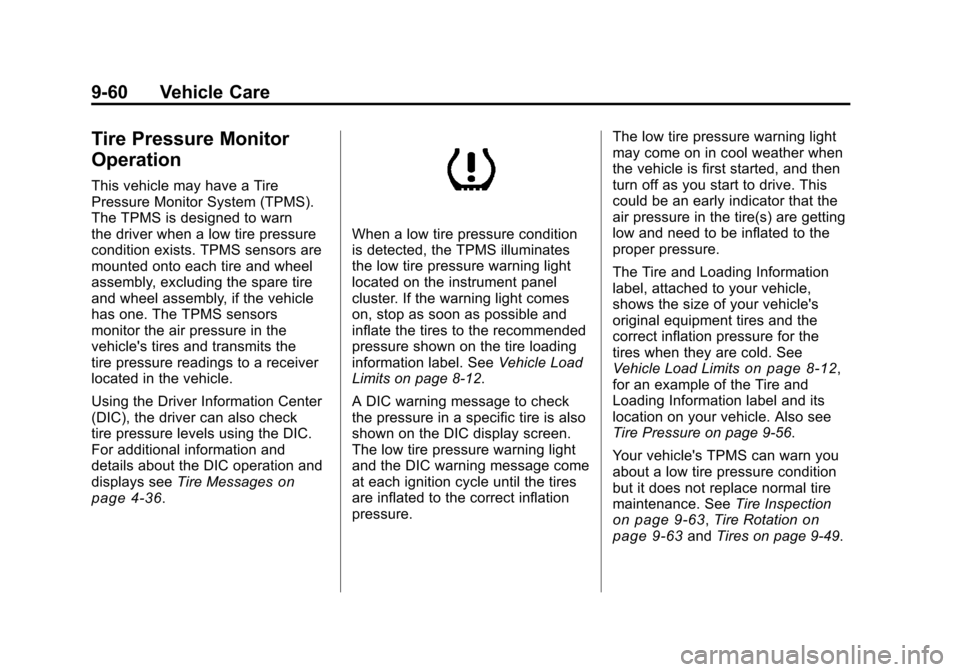
Black plate (60,1)Chevrolet Camaro Owner Manual - 2010
9-60 Vehicle Care
Tire Pressure Monitor
Operation
This vehicle may have a Tire
Pressure Monitor System (TPMS).
The TPMS is designed to warn
the driver when a low tire pressure
condition exists. TPMS sensors are
mounted onto each tire and wheel
assembly, excluding the spare tire
and wheel assembly, if the vehicle
has one. The TPMS sensors
monitor the air pressure in the
vehicle's tires and transmits the
tire pressure readings to a receiver
located in the vehicle.
Using the Driver Information Center
(DIC), the driver can also check
tire pressure levels using the DIC.
For additional information and
details about the DIC operation and
displays seeTire Messages
on
page 4‑36.
When a low tire pressure condition
is detected, the TPMS illuminates
the low tire pressure warning light
located on the instrument panel
cluster. If the warning light comes
on, stop as soon as possible and
inflate the tires to the recommended
pressure shown on the tire loading
information label. See Vehicle Load
Limits on page 8‑12.
A DIC warning message to check
the pressure in a specific tire is also
shown on the DIC display screen.
The low tire pressure warning light
and the DIC warning message come
at each ignition cycle until the tires
are inflated to the correct inflation
pressure. The low tire pressure warning light
may come on in cool weather when
the vehicle is first started, and then
turn off as you start to drive. This
could be an early indicator that the
air pressure in the tire(s) are getting
low and need to be inflated to the
proper pressure.
The Tire and Loading Information
label, attached to your vehicle,
shows the size of your vehicle's
original equipment tires and the
correct inflation pressure for the
tires when they are cold. See
Vehicle Load Limits
on page 8‑12,
for an example of the Tire and
Loading Information label and its
location on your vehicle. Also see
Tire Pressure on page 9‑56.
Your vehicle's TPMS can warn you
about a low tire pressure condition
but it does not replace normal tire
maintenance. See Tire Inspection
on page 9‑63,Tire Rotationon
page 9‑63and Tires on page 9‑49.
Page 293 of 378

Black plate (61,1)Chevrolet Camaro Owner Manual - 2010
Vehicle Care 9-61
Notice:Using non‐approved tire
sealants could damage the Tire
Pressure Monitor System (TPMS)
sensors. TPMS sensor damage
caused by using an incorrect tire
sealant is not covered by the
vehicle warranty. Always use
the GM approved tire sealant
available through your dealer.
Factory-installed Tire Inflator Kits
use a GM approved liquid tire
sealant. Using non-approved tire
sealants could damage the TPMS
sensors. See Tire Sealant and
Compressor Kit
on page 9‑73for
information regarding the inflator kit
materials and instructions.
TPMS Malfunction Light and
Message
The TPMS will not function properly
if one or more of the TPMS sensors
are missing or inoperable. When the
system detects a malfunction, the
low tire warning light flashes for
about one minute and then stays
on for the remainder of the ignition
cycle. A DIC warning message is
also displayed. The low tire warning
light and DIC warning message
come on at each ignition cycle until
the problem is corrected. Some of
the conditions that can cause the
malfunction light and DIC message
to come on are:
.One of the road tires has been
replaced with the spare tire,
if the vehicle has one. The spare
tire does not have a TPMS
sensor. The DIC message
should go off once you re‐install
the road tire containing the
TPMS sensor.
.The TPMS sensor matching
process was not done or not
completed successfully after
rotating the vehicle's tires.
The DIC message should go
off after successfully completing
the sensor matching process.
See “TPMS Sensor Matching
Process” later in this section.
.One or more TPMS sensors are
missing or damaged. The DIC
message and the TPMS
malfunction light should go
off when the TPMS sensors
are installed and the sensor
matching process is performed
successfully. See your dealer
for service.
.Replacement tires or wheels do
not match your vehicle's original
equipment tires or wheels. Tires
and wheels other than those
recommended for your vehicle
could prevent the TPMS from
functioning properly. See Buying
New Tires on page 9‑65.
Page 295 of 378
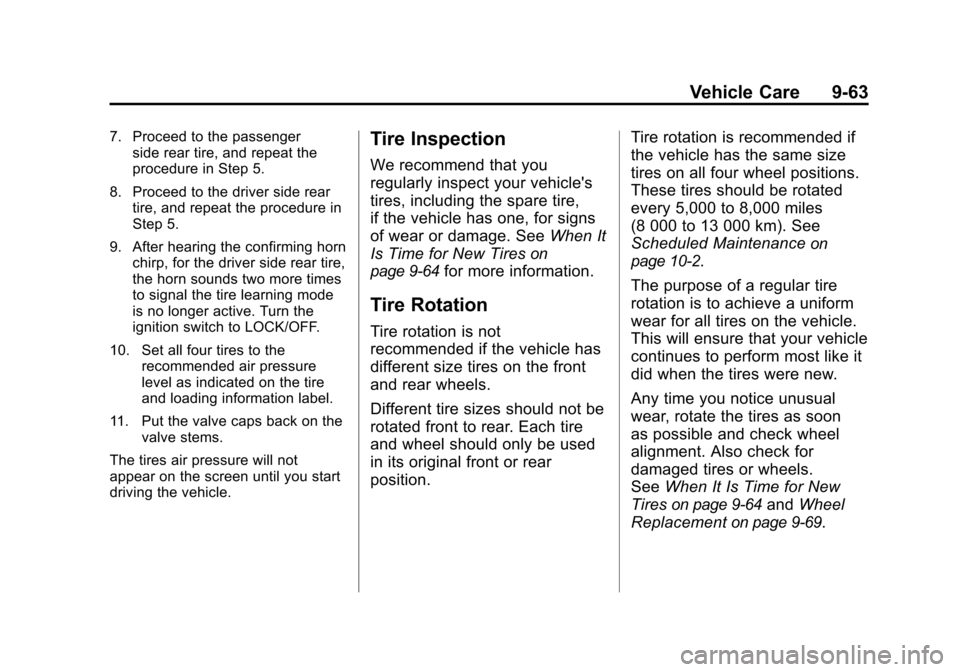
Black plate (63,1)Chevrolet Camaro Owner Manual - 2010
Vehicle Care 9-63
7. Proceed to the passengerside rear tire, and repeat the
procedure in Step 5.
8. Proceed to the driver side rear tire, and repeat the procedure in
Step 5.
9. After hearing the confirming horn chirp, for the driver side rear tire,
the horn sounds two more times
to signal the tire learning mode
is no longer active. Turn the
ignition switch to LOCK/OFF.
10. Set all four tires to the recommended air pressure
level as indicated on the tire
and loading information label.
11. Put the valve caps back on the valve stems.
The tires air pressure will not
appear on the screen until you start
driving the vehicle.Tire Inspection
We recommend that you
regularly inspect your vehicle's
tires, including the spare tire,
if the vehicle has one, for signs
of wear or damage. See When It
Is Time for New Tires
on
page 9‑64
for more information.
Tire Rotation
Tire rotation is not
recommended if the vehicle has
different size tires on the front
and rear wheels.
Different tire sizes should not be
rotated front to rear. Each tire
and wheel should only be used
in its original front or rear
position. Tire rotation is recommended if
the vehicle has the same size
tires on all four wheel positions.
These tires should be rotated
every 5,000 to 8,000 miles
(8 000 to 13 000 km). See
Scheduled Maintenance
on
page 10‑2
.
The purpose of a regular tire
rotation is to achieve a uniform
wear for all tires on the vehicle.
This will ensure that your vehicle
continues to perform most like it
did when the tires were new.
Any time you notice unusual
wear, rotate the tires as soon
as possible and check wheel
alignment. Also check for
damaged tires or wheels.
See When It Is Time for New
Tires
on page 9‑64and Wheel
Replacement
on page 9‑69.
Page 296 of 378

Black plate (64,1)Chevrolet Camaro Owner Manual - 2010
9-64 Vehicle Care
When rotating the vehicle's tires,
always use the correct rotation
pattern shown here.
The compact spare tire, if the
vehicle has one, is not included
in the tire rotation.
After the tires have been
rotated, adjust the front and
rear inflation pressures as
shown on the Tire and Loading
Information label. SeeTire
Pressure
on page 9‑56and
Vehicle Load Limits
on
page 8‑12
. Reset the Tire Pressure Monitor
System. See
Tire Pressure
Monitor Operation
on page 9‑60.
Make certain that all wheel
nuts are properly tightened.
See “Wheel Nut Torque” under
Capacities and Specifications
on
page 11‑2
.
{WARNING
Rust or dirt on a wheel, or on the
parts to which it is fastened, can
make wheel nuts become loose
after time. The wheel could come
off and cause an accident. When
changing a wheel, remove any
rust or dirt from places where
the wheel attaches to the vehicle.
In an emergency, use a cloth or a
paper towel to do this; but be sure
to use a scraper or wire brush
later, if needed, to get all the rust
or dirt off. See If a Tire Goes Flat
on page 9‑71.
When It Is Time for New
Tires
Various factors, such as
maintenance, temperatures, driving
speeds, vehicle loading, and road
conditions influence when you need
new tires.
One way to tell when it is time for
new tires is to check the treadwear
indicators, which appear when the
tires have only 1.6 mm (1/16 inch) or
less of tread remaining.
Page 298 of 378
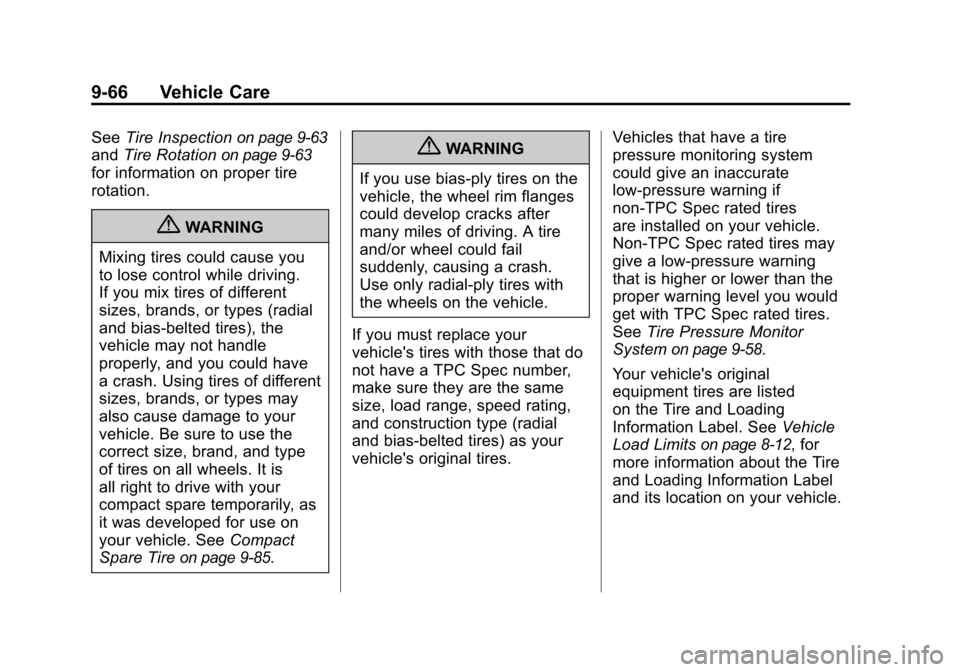
Black plate (66,1)Chevrolet Camaro Owner Manual - 2010
9-66 Vehicle Care
SeeTire Inspectionon page 9‑63
andTire Rotationon page 9‑63
for information on proper tire
rotation.
{WARNING
Mixing tires could cause you
to lose control while driving.
If you mix tires of different
sizes, brands, or types (radial
and bias-belted tires), the
vehicle may not handle
properly, and you could have
a crash. Using tires of different
sizes, brands, or types may
also cause damage to your
vehicle. Be sure to use the
correct size, brand, and type
of tires on all wheels. It is
all right to drive with your
compact spare temporarily, as
it was developed for use on
your vehicle. See Compact
Spare Tire
on page 9‑85.
{WARNING
If you use bias-ply tires on the
vehicle, the wheel rim flanges
could develop cracks after
many miles of driving. A tire
and/or wheel could fail
suddenly, causing a crash.
Use only radial-ply tires with
the wheels on the vehicle.
If you must replace your
vehicle's tires with those that do
not have a TPC Spec number,
make sure they are the same
size, load range, speed rating,
and construction type (radial
and bias‐belted tires) as your
vehicle's original tires. Vehicles that have a tire
pressure monitoring system
could give an inaccurate
low‐pressure warning if
non‐TPC Spec rated tires
are installed on your vehicle.
Non‐TPC Spec rated tires may
give a low‐pressure warning
that is higher or lower than the
proper warning level you would
get with TPC Spec rated tires.
See
Tire Pressure Monitor
System
on page 9‑58.
Your vehicle's original
equipment tires are listed
on the Tire and Loading
Information Label. See Vehicle
Load Limits
on page 8‑12, for
more information about the Tire
and Loading Information Label
and its location on your vehicle.
Page 304 of 378
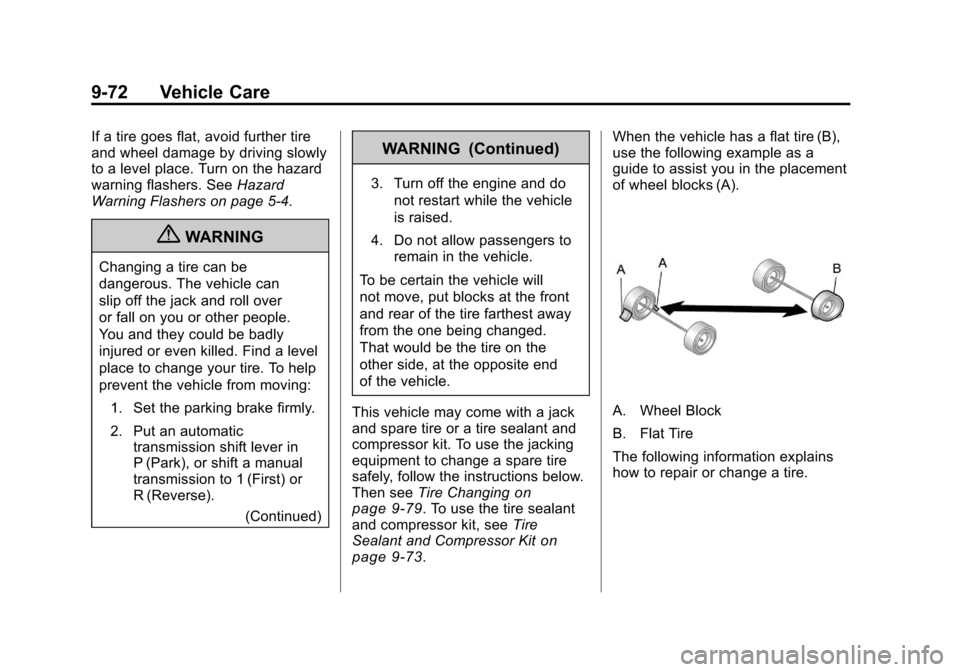
Black plate (72,1)Chevrolet Camaro Owner Manual - 2010
9-72 Vehicle Care
If a tire goes flat, avoid further tire
and wheel damage by driving slowly
to a level place. Turn on the hazard
warning flashers. SeeHazard
Warning Flashers on page 5‑4.
{WARNING
Changing a tire can be
dangerous. The vehicle can
slip off the jack and roll over
or fall on you or other people.
You and they could be badly
injured or even killed. Find a level
place to change your tire. To help
prevent the vehicle from moving:
1. Set the parking brake firmly.
2. Put an automatic transmission shift lever in
P (Park), or shift a manual
transmission to 1 (First) or
R (Reverse).
(Continued)
WARNING (Continued)
3. Turn off the engine and donot restart while the vehicle
is raised.
4. Do not allow passengers to remain in the vehicle.
To be certain the vehicle will
not move, put blocks at the front
and rear of the tire farthest away
from the one being changed.
That would be the tire on the
other side, at the opposite end
of the vehicle.
This vehicle may come with a jack
and spare tire or a tire sealant and
compressor kit. To use the jacking
equipment to change a spare tire
safely, follow the instructions below.
Then see Tire Changing
on
page 9‑79. To use the tire sealant
and compressor kit, see Tire
Sealant and Compressor Kit
on
page 9‑73. When the vehicle has a flat tire (B),
use the following example as a
guide to assist you in the placement
of wheel blocks (A).
A. Wheel Block
B. Flat Tire
The following information explains
how to repair or change a tire.